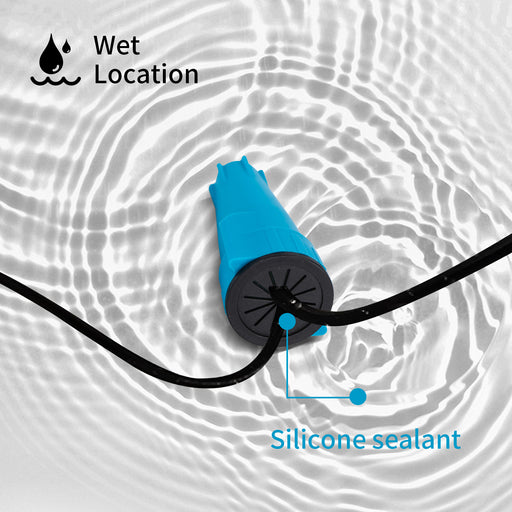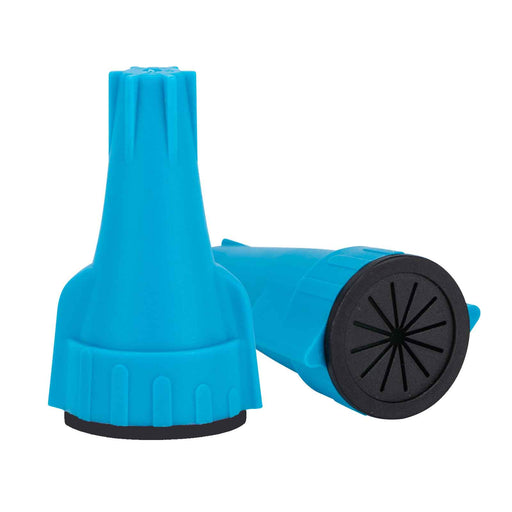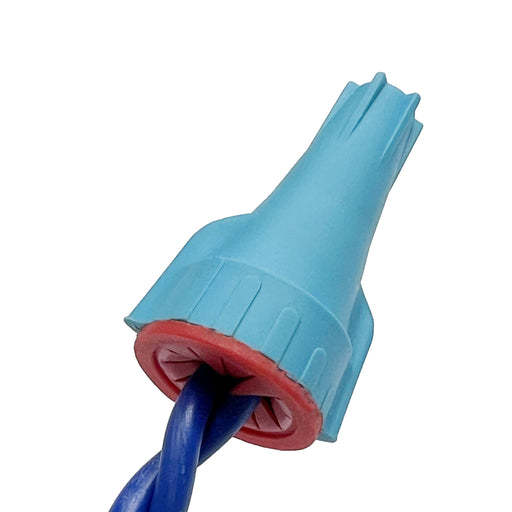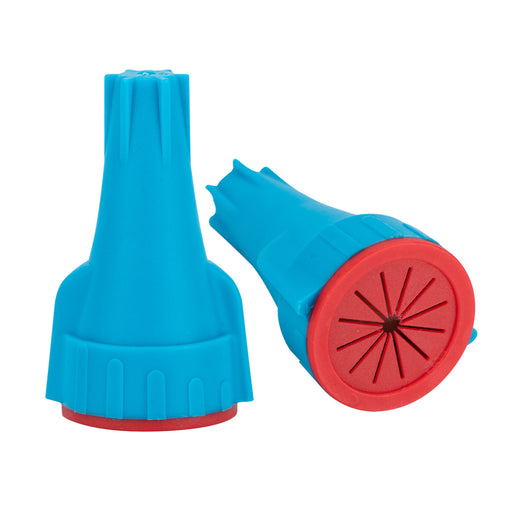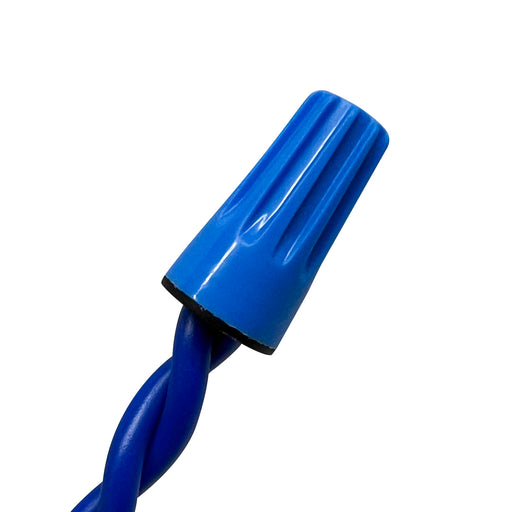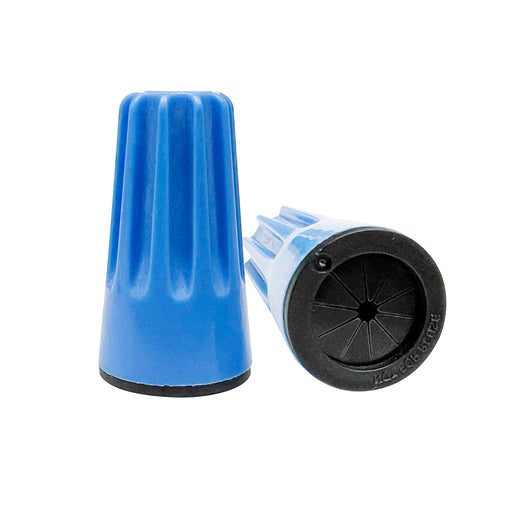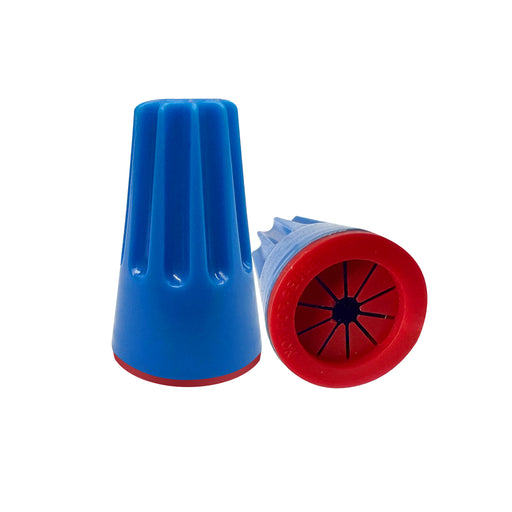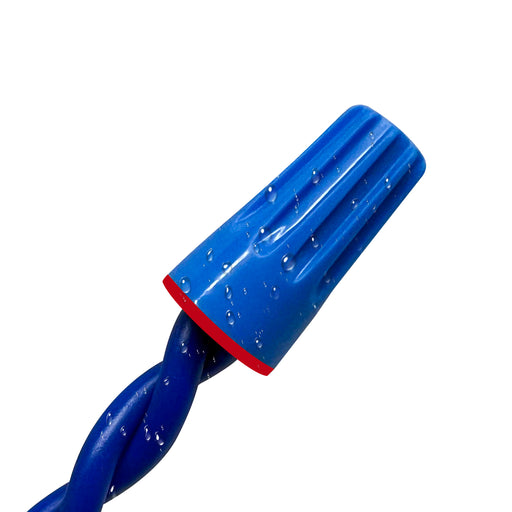
Waterproof Wire Connectors: UL-Listed Professional Installation Guide for Electricians
Professional electricians' guide to UL486D waterproof wire connectors. Covers NEC code compliance, installation techniques, and IP68 rating selection for landscape lighting and outdoor electrical work.
Outdoor electrical connections have one sworn enemy that almost always wins eventually: water. It works its way into junction points, copper starts corroding, and you earn a callback six months after the job looked perfect. When you’re wiring landscape lighting systems, irrigation controls, or direct burial applications, the key to avoiding those failures is understanding how waterproof wire connectors (waterproof wire nuts) function and which silicone-filled connectors truly hold up in the field.
This professional installation guide explains connector design, UL certification standards, NEC code requirements, and proven installation techniques that keep outdoor electrical connections dry and reliable for years rather than months.
Need connectors that meet full IP68 protection?
Check out our range of UL-486D-approved waterproof wire connectors designed for outdoor electrical installations.
How Housing, Sealant, and Closure Create Waterproof Protection
![]()
Reliable waterproof wire connectors rely on three essential engineered components that work together to protect wire junctions over time:
- Outer housing – Blocks moisture using flame-retardant thermoplastic materials that resist cracking and remain durable under stress.
- Internal silicone sealant – Surrounds wire connections completely with a protective compound that prevents water ingress.
- Threaded closure – Compresses the sealant and housing to create a tight, lasting seal even in tough conditions like repeated freeze-thaw cycles ranging from -55°C to +200°C, salt spray exposure for hundreds of hours, high-pressure water jets, continuous submersion beyond one meter depth, and mechanical stress from temperature cycling that causes materials to expand and contract.
Budget connectors often sacrifice one of these crucial components to reduce cost. You’ll find cheap petroleum-based gels instead of quality silicone, brittle housings that crack when temperatures fluctuate, or closures that gradually loosen after repeated use.
Understanding What IP68 Ratings Tell You

IP ratings define how much environmental exposure a connector can handle and what level of protection it provides:
- First digit (6) – Prevents dust or dirt from entering the housing under any condition.
- Second digit (8) – Allows continuous submersion beyond one meter depth without performance loss.
Lower ratings have serious limitations that will bite you later:
- IP67 - Handles temporary submersion only, then fails
- IP65 - Stops water jets but fails completely under immersion
For permanent outdoor installations, always use IP68-rated waterproof connectors. This ensures complete moisture protection and long-term durability in harsh environments.
Why Silicone-Filled Connectors Outperform Petroleum Gel Alternatives
Waterproof wire connector manufacturers face a crucial choice between silicone-filled and petroleum gel-filled internal sealants. This decision affects long-term reliability more than any other single design element, particularly for direct burial applications and landscape lighting installations.
Advantages of silicone-filled connectors:
- Maintain protective properties from -40°F to 221°F without degrading.
- Chemically bond to the housing walls and remain stable during temperature shifts.
- Resist displacement during repeated freeze-thaw cycles.
- Contain pre-measured silicone volumes that guarantee consistent sealing.
- Offer superior dielectric strength for enhanced electrical protection.
Petroleum gel problems that cause outdoor electrical connection failures:
- Becomes liquid mess in high temperatures, leaving wires exposed
- Turns rock-hard and brittle in freezing conditions
- Migrates away from wire contact points over time
- Often separates completely after several years in direct burial applications
- Can compromise electrical integrity under load conditions
Professional landscape lighting and irrigation installations require pre-filled silicone connectors with measured sealant volumes. Field-applied petroleum gels introduce too many variables that compromise long-term performance in outdoor electrical connections.
Waterproof Landscape Wire Connectors for Outdoor Lighting Systems
Landscape lighting installations demand specialized waterproof wire connectors (often called waterproof wire nuts) that handle both environmental challenges and specific voltage requirements. Low-voltage landscape lighting systems typically operate at 12 volts, but the outdoor environment creates unique demands that standard indoor wire nuts cannot meet.
12 Volt Landscape Lighting Wire Connector Requirements
Professional landscape lighting installations require waterproof wire connectors that meet specific performance criteria:
- Voltage rating compatibility - Must handle 12V, 24V, and line voltage applications safely
- Wire gauge flexibility - Accommodate 18 AWG to 12 AWG landscape lighting wire combinations
- Moisture barrier integrity - Maintain IP68 protection in buried landscape lighting junction boxes
- Temperature stability - Function reliably from winter freezing to summer heat extremes
- Soil chemistry resistance - Withstand fertilizer exposure and irrigation system chemicals
Landscape lighting wire connectors face unique stresses from seasonal ground movement, root growth pressure, and irrigation system proximity. Silicone-filled waterproof connectors provide superior protection compared to petroleum gel alternatives commonly sold for outdoor use.
Best Practices for Landscape Lighting Electrical Connections
Junction Box Placement Strategy
Position waterproof junction boxes for landscape lighting connections in accessible locations that avoid sprinkler spray patterns and heavy foot traffic areas. Proper placement prevents mechanical damage while maintaining service access.
Wire Preparation for Landscape Connectors
Strip landscape lighting wire to manufacturer specifications, typically 1/2 inch for most waterproof wire connectors. Clean copper conductors remove oxidation that can create high-resistance connections in outdoor environments.
Burial Depth Compliance
Install landscape lighting wire connections at a minimum 6-inch depth per NEC Article 300.5 requirements for low-voltage systems. Deeper burial provides additional protection from mechanical damage and temperature extremes.
For comprehensive voltage drop calculations, wire sizing charts, and step-by-step landscape lighting installation procedures, see our professional landscape lighting wire connection guide (coming soon!).
UL486G Expands to Cover Direct Burial Applications (July 2024 Update)
UL develops different testing standards based on where you're installing. Specifying the wrong standard can delay jobs and create expensive inspection problems.
The July 2024 revision of UL486G changed the rules. Direct buried locations, below-grade installations, and above-grade applications that are protected from direct sunlight now fall under UL486G certification. This puts UL486G nearly on par with UL486D for most outdoor electrical work.
Underground Sprinkler Wire Connectors and Irrigation System Requirements

Irrigation control systems present some of the most challenging environments for waterproof electrical connections. Underground sprinkler wire connectors must withstand continuous moisture exposure, aggressive soil chemistry from fertilizers, and mechanical stress from seasonal ground movement.
Critical Requirements for Irrigation Wire Connectors:
- Continuous submersion capability – Handle seasonal groundwater fluctuations and irrigation overflow
- Chemical resistance – Withstand fertilizer exposure and soil treatment chemicals
- Multi-conductor capacity – Connect control wires for multiple valve zones efficiently
- Service accessibility – Allow future maintenance without complete excavation
- Corrosion prevention – Protect copper conductors from galvanic corrosion
Professional irrigation installations can now use either UL486D or UL486G-listed waterproof wire connectors for direct burial applications. The updated UL486G standard specifically covers underground feeder cable, golf course sprinkler cable, underground low energy cable, and irrigation cable.
Installation Techniques for Irrigation Control Wiring:
Install irrigation wire connectors in properly sized underground junction boxes with adequate drainage. Use silicone-filled waterproof connectors rather than petroleum gel alternatives that migrate away from connections over time. Position junction boxes away from irrigation spray patterns while maintaining accessible service locations.
Direct Burial Wire Connector Code Requirements
Direct Burial Applications Need UL486D Testing for Extreme Conditions
Direct burial waterproof wire connectors facing the worst underground conditions still benefit from UL486D certification testing:
- Resistance to aggressive soil acids and harsh agricultural chemicals
- Long-term groundwater submersion survival without degradation
- Electrical performance through repeated freeze-thaw cycling punishment
- Mechanical integrity under soil movement stress and root pressure
Commercial irrigation systems, flood-prone installations, and any buried electrical connections in aggressive environments need UL486D-certified products.
UL486G Now Covers Most Outdoor Applications
UL486G testing now includes direct burial applications where protected from direct sunlight exposure. This expanded coverage handles standard soil conditions, typical landscape lighting installations, and most irrigation control wiring without requiring UL486D certification.
Both R3/R6 series (UL486D) and P3W/P4W series (UL486G) connectors work for most outdoor applications, including irrigation and landscape direct burial. Choose based on environmental severity rather than application type.
Understanding the Sunlight Protection Requirement
The updated UL486G standard includes protection from direct sunlight exposure. Surface installations need adequate UV protection through conduit, enclosures, or building coverage to qualify for UL486G certification.
Spotting Authentic UL Certification
Counterfeit UL claims absolutely flood online marketplaces, particularly Amazon and eBay. Authentic UL certification requires specific markings printed directly on individual connectors, not just flashy packaging claims.
Real UL testing includes brutal conditions:
- Electrical stress up to 600 volts repeatedly
- Hundreds of temperature cycles that would destroy cheap alternatives
- Salt spray corrosion exposure for extended periods
- Months of environmental conditioning that separates quality from junk
Many online sellers boldly claim "UL listed" in product descriptions while selling connectors that never underwent any testing whatsoever. Check for printed UL marks on each connector before ordering. Using uncertified products puts your professional reputation and customer safety at serious risk.
NEC Code Requirements for Outdoor Wire Connections in United States
The National Electrical Code establishes specific requirements for outdoor electrical installations across the United States that directly impact waterproof wire connector selection and installation practices. Regional electrical inspectors consistently check these compliance points during outdoor electrical work inspections.
Article 110.3(B) Equipment Installation Requirements for North American Installations
NEC 110.3(B) requires electrical equipment to be installed according to UL listing instructions throughout the United States. For waterproof wire connectors, this creates several critical compliance points that electrical inspectors verify:
- Using connectors within their rated voltage and current limits
- Following manufacturer installation instructions precisely
- Ensuring wire gauge compatibility matches connector specifications
- Maintaining proper burial depths when specified for direct burial applications
Inspectors check these requirements regularly, and violations can shut down job sites until corrected.
Wet Location Standards Under Article 300.6
Article 300.6(A) addresses equipment installation in wet locations. Waterproof electrical connectors must meet specific criteria:
- Listed specifically for wet location use
- Installed to prevent water accumulation around connections
- Protected from mechanical damage when used in buried applications
Generic indoor wire nuts cannot legally substitute for properly rated waterproof connectors in outdoor installations.
Direct Burial Requirements from Article 300.5
When waterproof wire connectors are used in direct burial applications like landscape lighting or irrigation systems, NEC Article 300.5 specifies minimum burial depths:
- Low-voltage systems (30V or less) - 6 inches minimum depth
- Higher voltage systems - go out depending on specific application
All buried connections must remain accessible for future maintenance and use connectors specifically rated for direct burial conditions.
Professional Installation Techniques That Prevent Failures
Even the highest quality waterproof wire connectors fail if installed incorrectly. Proper technique often makes more difference than the connector itself.
Wire Preparation That Creates Reliable Connections

Strip Length Precision
Follow the strip gauge molded into the connector body religiously. Most waterproof connectors require exactly 3/8 to 1/2 inch of exposed conductor. Too little prevents full insertion. Too much leaves bare copper exposed outside the protective seal.
Wire Condition Standards
Use only clean, undamaged conductors for waterproof connections. Nick marks or existing corrosion on copper wire create failure points that compromise the entire connection. Cut back to clean copper before making any waterproof connection.
Solid vs Stranded Compatibility
Check connector specifications carefully. Some waterproof electrical connectors optimize for solid copper wire, while others accommodate both solid and stranded conductors. Using the wrong wire type can prevent proper sealing.
Step-by-Step Installation Process
Power Disconnection Verification
Always verify power disconnection at the transformer or breaker before handling any wiring. Test with a meter, not just switch position. Landscape lighting transformers can hold charge even when switched off.
Wire Preparation and Grouping
Strip wires to the exact length specified by the connector strip gauge. For multi-wire connections, we recommend pre-twisting conductors clockwise when combining solid and stranded wires to create a unified bundle that ensures good insertion.
Full Insertion Technique
Push the wire bundle completely into the waterproof connector until it stops against the internal barrier. Partial insertion creates high-resistance connections that generate heat and eventually fail.
Sealing Mechanism Engagement
Twist the connector closure clockwise until the sealing mechanism fully engages. You should feel positive resistance as the internal threads compress the silicone seal around the wire bundle.
Visual Inspection Requirements
Ensure no bare copper appears outside the connector body after installation. Any exposed conductor compromises waterproof protection and creates potential arc hazards.
Common Installation Mistakes That Cause Failures
Over-stripping Wire Ends
Stripping too much insulation exposes copper outside the protective seal. This creates immediate failure points and violates NEC requirements for proper insulation.
Under-insertion Problems
Wires not fully seated in waterproof connectors create high-resistance connections. These generate heat, cause voltage drop, and eventually burn out completely.
Cross-threading Damage
Forcing connector seals can damage internal threading and compromise waterproof performance. If resistance feels excessive, back out and try again rather than forcing closure.
Connector Reuse Attempts
Most silicone-filled waterproof wire connectors are designed for single use only. The sealing chamber deforms during installation and won't provide reliable protection if removed and reinstalled.
Wire Gauge Compatibility and Proper Sizing
Waterproof electrical connectors come in different sizes to accommodate various wire combinations. Understanding capacity ratings prevents overloading and ensures reliable long-term performance.
Standard Waterproof Connector Size Categories
Small Waterproof Connectors (P4W Series)
Accommodate 20-12 AWG wire combinations with typical capacity for 2-3 conductors depending on specific wire gauge. These compact connectors work well for low-voltage landscape lighting and small irrigation control applications. Dimensions measure 0.53" diameter x 0.95" length for tight installation spaces.
Medium Waterproof Connectors (R3 Series)
Handle 20-10 AWG wire combinations with capacity for 2-4 conductors depending on wire gauge selection. These versatile connectors suit larger landscape systems and irrigation mainline applications. Dimensions measure 0.98" diameter x 1.61" length for easier handling during installation.
Large Waterproof Connectors (R6 Series)
Designed for 14-8 AWG applications with capacity for 2-6 conductors depending on specific wire gauge combinations. These robust connectors handle commercial irrigation systems and large landscape installations. The larger size provides better grip when wearing work gloves.
Wire Combination Examples for Different Applications

12 AWG Landscape Lighting Systems
For typical residential landscape lighting using 12 AWG copper wire:
- 2 x 12 AWG conductors - Use medium or large waterproof connectors
- 3 x 12 AWG conductors - Requires large connector only
Our landscape lighting wire connection guide provides detailed calculations and installation techniques for reliable 12V systems.
14 AWG Irrigation Control Wiring
Common irrigation control circuits using 14 AWG multi-conductor cable:
- 2 x 14 AWG conductors - Any size works, small connectors most economical
- 4 x 14 AWG conductors - Medium or large waterproof connectors required
Mixed Gauge Applications
When combining different wire sizes in single connections:
- 1 x 12 AWG + 2 x 14 AWG conductors - Medium connector minimum requirement
Always check manufacturer fill charts for specific combinations before installation
Landscape Lighting and Irrigation Applications
Waterproof wire connectors serve critical roles in outdoor electrical systems where moisture exposure is constant and connection reliability directly impacts system performance.
Need reliable connectors for your next landscape lighting project?
Explore our UL-486D-approved waterproof wire connectors built for low-voltage outdoor systems.
Landscape Lighting System Requirements
Low-voltage landscape lighting creates unique challenges for waterproof electrical connections that standard indoor products cannot handle.
12V/24V System Considerations
Lower operating voltage doesn't reduce reliability requirements for outdoor connections. Poor connections in landscape lighting cause voltage drop, leading to dim LED performance and shortened fixture life. Quality waterproof wire connectors maintain consistent electrical contact even in moisture-rich environments.
Critical Connection Points
Landscape lighting systems have several vulnerable connection areas:
- Fixture tap connections where individual lights connect to main runs
- Junction splices for multiple lighting circuits
- Transformer secondary connections at the power source • Controller interface wiring for automated systems
Each connection point requires waterproof protection rated for the installation environment.
Planning for Future Expansion
Size waterproof connector selections to accommodate future lighting additions. Installing larger waterproof wire connectors initially costs less than returning to upgrade junction points when adding fixtures later.
Irrigation and Sprinkler System Protection

Irrigation control wiring operates in the harshest environment for electrical connections. Constant moisture, soil chemicals, and physical stress from landscaping equipment create conditions that destroy standard connections quickly.
24V AC Valve Control Circuits
Most irrigation systems use 24V AC control circuits that require waterproof electrical connectors capable of handling both moisture exposure and electromagnetic interference from solenoid switching. Quality connectors prevent voltage drop that causes erratic valve operation.
Multi-Conductor Control Cable Connections
Irrigation controllers use multi-conductor cables that need reliable splice connections resistant to corrosion and moisture intrusion. Waterproof wire connectors must accommodate multiple small-gauge conductors while maintaining individual circuit isolation.
Pump Control Applications
Higher-current pump control circuits require waterproof connectors with appropriate ampacity ratings. These connections handle both the electrical load and environmental exposure without degradation.
Direct Burial Installation Requirements
Any waterproof connector intended for direct burial must meet additional performance requirements beyond basic moisture protection.
Soil Chemistry Resistance
Underground waterproof electrical connectors face exposure to soil acids, fertilizer salts, and agricultural chemicals that accelerate corrosion of inferior products. UL486D certification verifies resistance to these aggressive conditions.
Physical Protection Needs
Buried connectors require protection from root intrusion and mechanical damage from lawn equipment. Plan installation depths and protective measures accordingly.
Accessibility Compliance
NEC requires that electrical splices remain accessible for future maintenance. Use junction boxes or direct-burial waterproof connectors specifically designed for permanent installation when accessibility is limited.
Quality vs Cost: Understanding the Real Price Difference
The electrical supply market includes dramatic price variation in waterproof wire connectors. Understanding total cost implications helps make informed purchasing decisions that protect profitability and reputation.
Hidden Costs of Low-Quality Connectors
Service Call Economics
A $0.25 connector that fails after six months costs $150+ in diagnostic time, travel expenses, and return visits. The labor cost to replace a failed connection often exceeds 100 times the original connector price.
Customer Relationship Impact
Unreliable waterproof connections damage customer trust and reduce referral business. Customers remember electrical problems long after they forget initial project costs.
Code Compliance Risks
Non-UL listed products may not pass electrical inspection, requiring complete rework with certified components. Inspection delays can shut down job sites and delay payment schedules.
Professional Liability Exposure
Using non-certified electrical components can affect insurance coverage and increase liability exposure if failures cause property damage or safety hazards.
Value Analysis of Quality Waterproof Connectors
Quality waterproof electrical connectors typically cost $0.50-$1.00 per connection. This price reflects several value components:
- UL testing and certification costs - Third-party verification of safety and performance
- Premium raw materials - Medical-grade silicone, flame-retardant housing compounds •
- Manufacturing quality control - Consistent sealant volumes, precision molding
- Technical documentation - Complete specification sheets, installation guidance
- Supply chain reliability - Consistent availability and predictable pricing
Identifying Quality Waterproof Wire Connector Products
UL Mark Verification
Look for the official UL mark printed on each individual connector, not just package claims. The mark should include the specific UL standard (UL486D or UL486G) and the manufacturer's control number.
Technical Documentation Quality
Professional manufacturers provide detailed specification sheets, including wire fill charts, temperature ratings, voltage limits, and installation instructions. Missing documentation usually indicates inferior products.
Installation Guidance Completeness
Quality waterproof connector manufacturers invest in clear installation instructions because product success depends on proper installation. Comprehensive guidance indicates manufacturer commitment to product performance.
Consistent Product Availability
Reliable manufacturers maintain consistent inventory and predictable delivery schedules. Frequent stock-outs or long lead times often indicate quality control problems or unstable supply chains.
Frequently Asked Questions About Waterproof Wire Connectors
What is the difference between UL486D and UL486G certification?
UL486D certification covers direct burial and underground waterproof wire connectors that can withstand continuous submersion, aggressive soil chemistry, and freeze-thaw cycling. UL486G certification covers general outdoor waterproof electrical connectors for above-ground installations only. For landscape lighting and irrigation systems, always specify UL486D listed products.
How many wires can fit in a waterproof wire connector?
Wire capacity depends on the specific connector size and wire gauge combination. Most waterproof wire connectors accommodate 2-4 conductors, with capacity decreasing as wire gauge increases. Always consult manufacturer fill charts rather than estimating capacity to ensure proper electrical performance and waterproof sealing.
What IP rating do I need for buried electrical connections?
Buried electrical connections require IP68 rated waterproof connectors that can withstand continuous submersion beyond one meter depth. IP67 rated connectors handle temporary moisture exposure only and will fail in permanent underground installations.
Can I reuse waterproof wire connectors during maintenance?
No, waterproof wire connectors are designed for single-use installation. The silicone sealant and housing compression cannot be restored after removal. Always replace waterproof connectors completely during maintenance rather than attempting reuse.
Do waterproof wire connectors work with aluminum conductors?
Most waterproof wire connectors are designed specifically for copper conductors. Using aluminum wire requires connectors specifically listed for aluminum compatibility to prevent galvanic corrosion and high-resistance connections. Check UL listing specifications before using with aluminum conductors. Note that aluminum-compatible connectors are typically rated for indoor use only. Outdoor waterproof connectors for aluminum applications have limited availability.
What wire stripping length do waterproof connectors require?
Strip length requirements vary by manufacturer and connector size, typically ranging from 1/2 inch to 3/4 inch. Always follow manufacturer instructions exactly, as insufficient insertion compromises both electrical performance and waterproof sealing.
How deep should landscape lighting wire connections be buried?
NEC Article 300.5 requires a minimum 6-inch burial depth for low-voltage landscape lighting systems (30V or less). Higher voltage outdoor electrical connections require 18-24 inch burial depth depending on specific application and local code requirements.
What's the difference between silicone-filled and gel-filled waterproof connectors?
Silicone-filled waterproof connectors maintain their protective properties across temperature extremes and bond permanently to housing walls. Petroleum gel-filled alternatives migrate away from connections over time and become brittle in cold weather or liquid in high temperatures, leading to connection failures.
Troubleshooting Common Waterproof Connector Failures
Even properly installed waterproof wire connectors can experience problems under certain conditions. Understanding failure modes helps with diagnosis, prevention, and warranty claims.
Moisture Intrusion Diagnosis
Visible Symptoms
Look for green patina formation on copper conductors, white corrosion deposits around connection points, or water droplets inside supposedly sealed connectors. These indicate moisture has penetrated the waterproof barrier.
Electrical Performance Issues
Moisture intrusion often causes intermittent circuit operation, voltage drop across connections, or complete circuit failure during wet weather periods.
Root Cause Analysis
Moisture problems typically result from improper installation techniques, connectors not rated for the application environment, or physical damage from landscaping equipment or root growth.
Prevention Strategies
Use properly rated waterproof electrical connectors, follow manufacturer installation procedures exactly, and provide adequate physical protection for buried connections.
High-Resistance Connection Problems
Performance Symptoms
High resistance connections cause voltage drop across the connection point, heating at the connector location, and reduced performance in connected equipment like dim LED lights or weak solenoid operation.
Common Causes
Corroded wire ends before installation, inadequate wire insertion into the connector chamber, or overloaded connectors with too many or too large conductors create high resistance problems.
Diagnostic Techniques
Use a multimeter to measure voltage drop across suspected connections under load. Readings above 0.1V typically indicate connection problems requiring attention.
Prevention Methods
Always use clean, undamaged wire ends, follow connector fill capacity guidelines strictly, and ensure complete wire insertion during installation.
Mechanical Failure Issues
Physical Damage Symptoms
Look for cracked connector housings, separated sealing elements, loose connections that can be moved by hand, or visible deformation of the connector body.
Typical Causes
Physical stress from improper burial installation, temperature cycling beyond connector ratings, or attempted reuse of single-use waterproof connectors causes mechanical failures.
Repair vs Replacement Decisions
Mechanically damaged waterproof wire connectors cannot be reliably repaired. Replace failed connectors completely rather than attempting field repairs that compromise safety and performance.
Prevention Techniques
Protect buried connections from mechanical stress, verify connector temperature ratings exceed expected environmental conditions, and replace rather than reuse connectors during maintenance.
Professional Grade vs. Consumer Grade Waterproof Connectors
The waterproof connector market includes both professional-grade waterproof wire nuts designed for electrical contractors and consumer-grade waterproof wire connectors sold through general retail channels. Understanding these differences helps ensure reliable outdoor electrical connections.
Professional Grade Waterproof Wire Connector Characteristics:
- UL486D or UL486G certification from independent testing laboratories
- Detailed technical specifications, including wire fill charts and temperature ratings
- Silicone-filled sealant chambers with measured volumes for consistent protection
- Flame-retardant housing materials that meet electrical safety standards
- Clear installation instructions and technical support availability
Consumer Grade Connector Limitations:
- Often lack UL certification or use misleading certification claims
- Petroleum gel sealants that migrate away from connections over time
- Vague specifications without proper wire gauge or temperature ratings
- Inconsistent quality control leading to premature failure rates
- Limited technical documentation or installation guidance
For landscape lighting installations, irrigation control systems, and other professional outdoor electrical work, specify professional grade waterproof wire nuts that meet UL standards rather than generic landscape wire connectors that may compromise system reliability and code compliance. U.S. installers often refer to these products as landscape wire nuts when discussing waterproof connections for outdoor lighting systems.
How Installation Environment Affects Waterproof Connector Selection
Different outdoor electrical applications create specific environmental challenges that influence waterproof wire connector selection. Understanding these conditions helps prevent connection failures and unnecessary service calls.
Direct Burial Applications (Landscape Lighting, Irrigation): Require UL486D listed waterproof wire nuts with IP68 rating for continuous submersion capability. Silicone-filled chambers resist soil chemistry and temperature cycling better than petroleum gel alternatives.
Above-Ground Outdoor Use (Exterior Fixtures, Pool Equipment): UL486G listed waterproof wire connectors provide adequate protection for installations not exposed to continuous moisture. Still require IP67 minimum rating for reliable weather resistance.
Marine and Coastal Installations:
Salt air exposure demands enhanced corrosion resistance. Look for waterproof wire nuts specifically tested for salt spray exposure with marine-grade materials and coatings.
Professional Product Selection Guidelines
Choosing appropriate waterproof electrical connectors requires matching product specifications to application requirements and environmental conditions.
Critical Selection Criteria
Voltage Rating Requirements
Always specify waterproof connectors with voltage ratings that exceed system requirements. Standard 600V ratings provide an adequate safety margin for virtually all low-voltage landscape and irrigation applications.
Wire Capacity Verification
Check manufacturer fill charts for specific wire gauge combinations rather than assuming capacity. Exceeding fill limits compromises both electrical performance and waterproof sealing.
Temperature Range Confirmation
Ensure connector temperature ratings exceed expected environmental conditions with an adequate safety margin. Standard ratings from -40°F to 221°F cover most outdoor applications effectively.
Certification Level Requirements
Verify UL486D certification for direct burial applications and UL486G for general outdoor use. Using connectors with insufficient certification creates code compliance problems.
Installation Method Considerations
Choose between tool-free and tool-required installation based on field conditions, technician skill levels, and productivity requirements.
Dicio Waterproof Connector Product Line
Dicio offers a comprehensive range of UL-listed waterproof electrical connectors engineered for professional electrical applications:
Extra Small Waterproof Connectors (P3W Series)
UL486G listed connectors for the smallest wire applications with ultra-compact dimensions for space-constrained installations. Pre-filled silicone chambers provide reliable moisture protection for tight junction areas.
Small Waterproof Connectors (P4W Series)
UL486G listed connectors for 20-12 AWG applications with compact dimensions are ideal for tight installation spaces. Pre-filled silicone chambers provide reliable moisture protection for above-ground outdoor use.
Medium Waterproof Connectors (R3 Series)
UL486D listed connectors for 20-10 AWG applications provide optimal balance between size and wire capacity. These versatile connectors handle most landscape lighting and irrigation applications effectively.
Large Waterproof Connectors (R6 Series)
UL486D listed connectors for 14-8 AWG applications with enhanced handling characteristics for work glove compatibility. Ideal for commercial installations and high-capacity residential systems.
Universal Design Features
All Dicio waterproof wire connectors include:
- Pre-filled silicone sealant chambers for consistent protection
- Tool-free installation reducing field time and complexity
- Color-coded options for circuit identification and phasing
- Clear installation markings eliminating guesswork
- 600V voltage rating providing generous safety margins
- Temperature range from -40°F to 221°F covering extreme conditions
Building Reliable Outdoor Electrical Connections That Last
The essential elements for professional waterproof electrical connections include:
Proper UL certification - Specify UL486D for direct burial applications like landscape lighting and irrigation systems, UL486G for above-ground outdoor electrical connections
Correct connector sizing - Match waterproof connector capacity to specific wire gauge combinations using manufacturer fill charts rather than estimating
Installation precision - Follow proper procedures including correct strip length, complete wire insertion, and adequate burial depth per NEC requirements
Environmental planning - Consider temperature extremes, soil chemistry exposure, irrigation system proximity, and long-term accessibility requirements for maintenance
Quality investment - Choose certified silicone-filled products over cheap petroleum gel alternatives that compromise safety and reliability
Need UL-listed waterproof wire connectors for your next outdoor electrical project?
Check out our range of UL-486D-approved waterproof wire connectors designed for outdoor electrical installations.
See the full landscape lighting wiring requirements and depth guidelines (coming soon!)
Featured collection
-
Original price $12.99 - Original price $25.99Original price $12.99 - Original price $25.99Original price $12.99$9.99 - $19.99$9.99 - $19.99Current price $9.99
Waterproof Landscape Wire Connectors [Large]
Dicio ConnectorsIn stockSuperior Defense for Outdoor and Irrigation Environments Model Number: R6 Certified Quality: UL Listed (UL486D), IP68 Rated Water Resistant: Si...
View full detailsOriginal price $12.99 - Original price $25.99Original price $12.99 - Original price $25.99Original price $12.99$9.99 - $19.99$9.99 - $19.99Current price $9.99Save up to 23% -
Original price $9.99 - Original price $133.99Original price $9.99 - Original price $133.99Original price $9.99$7.99 - $99.99$7.99 - $99.99Current price $7.99
Waterproof Landscape Wire Connectors [Medium]
Dicio ConnectorsIn stockDicio’s waterproof wire connectors are built to withstand the elements. Twist the wires together, insert into the pre-filled connector, and snap it...
View full detailsOriginal price $9.99 - Original price $133.99Original price $9.99 - Original price $133.99Original price $9.99$7.99 - $99.99$7.99 - $99.99Current price $7.99Save up to 25% -
Original price $11.99 - Original price $43.99Original price $11.99 - Original price $43.99Original price $11.99$9.99 - $38.90$9.99 - $38.90Current price $9.99
Waterproof Landscape Wire Connectors [Small]
Dicio ConnectorsLow stockResilient Waterproof Connectors for Ultimate Outdoor Protection Model Number: P4W Certified Quality: UL-listed (UL486G) to ensure safety and r...
View full detailsOriginal price $11.99 - Original price $43.99Original price $11.99 - Original price $43.99Original price $11.99$9.99 - $38.90$9.99 - $38.90Current price $9.99Save up to 12% -
Original price $19.99 - Original price $75.99Original price $19.99 - Original price $75.99Original price $19.99$15.99 - $69.99$15.99 - $69.99Current price $15.99
Waterproof Landscape Wire Connectors [Extra Small]
Dicio ConnectorsIn stockResilient Waterproof Connectors for Ultimate Outdoor Protection Model Number: P3W Certified Quality: UL-listed (UL486G) to ensure safety and r...
View full detailsOriginal price $19.99 - Original price $75.99Original price $19.99 - Original price $75.99Original price $19.99$15.99 - $69.99$15.99 - $69.99Current price $15.99Save up to 24% -
Original price $15.99Original price $15.99 - Original price $15.99Original price $15.99Current price $9.99$9.99 - $9.99Current price $9.99
Dicio 3:1 Heat Shrink Tubing Kit 180PC Waterproof Set
Dicio ConnectorsIn stockDicio’s 3:1 Heat Shrink Tubing Kit provides industrial-grade insulation, sealing, and protection for all your wiring needs. Designed with a double-...
View full detailsOriginal price $15.99Original price $15.99 - Original price $15.99Original price $15.99Current price $9.99$9.99 - $9.99Current price $9.99Save 38%

